Europe Insulin Delivery Devices Market Size
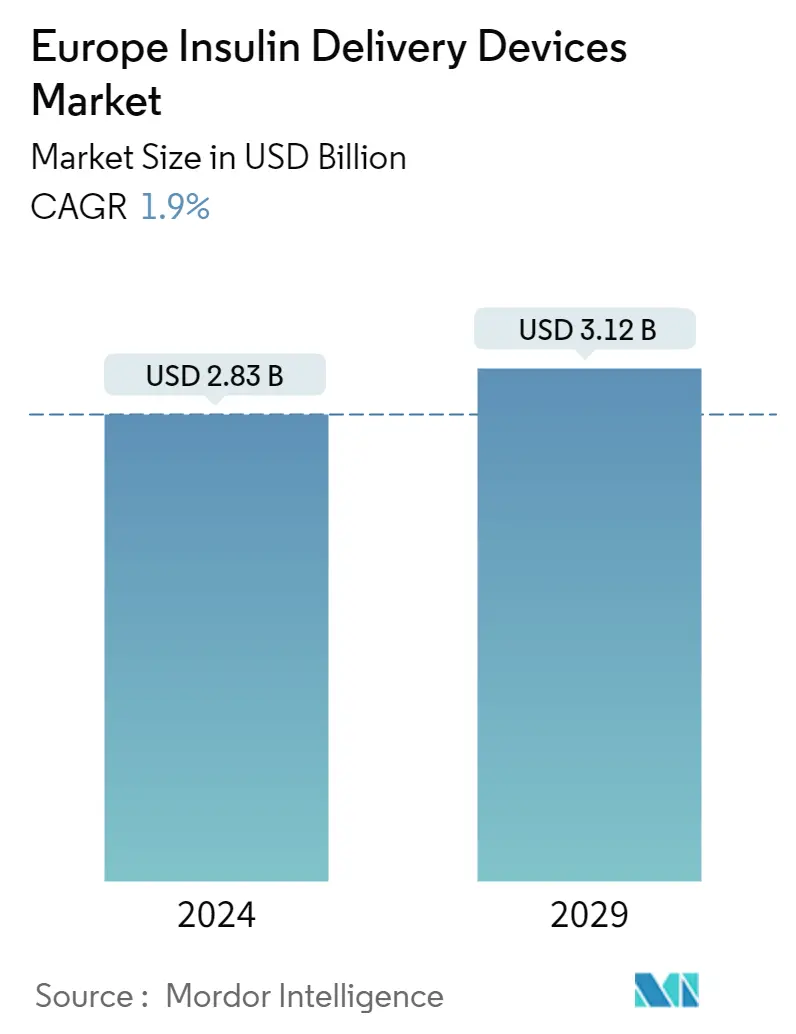
| Study Period | 2019 - 2029 |
| Base Year For Estimation | 2023 |
| Forecast Data Period | 2024 - 2029 |
| Market Size (2024) | USD 2.83 Billion |
| Market Size (2029) | USD 3.12 Billion |
| CAGR (2024 - 2029) | 1.90 % |
Major Players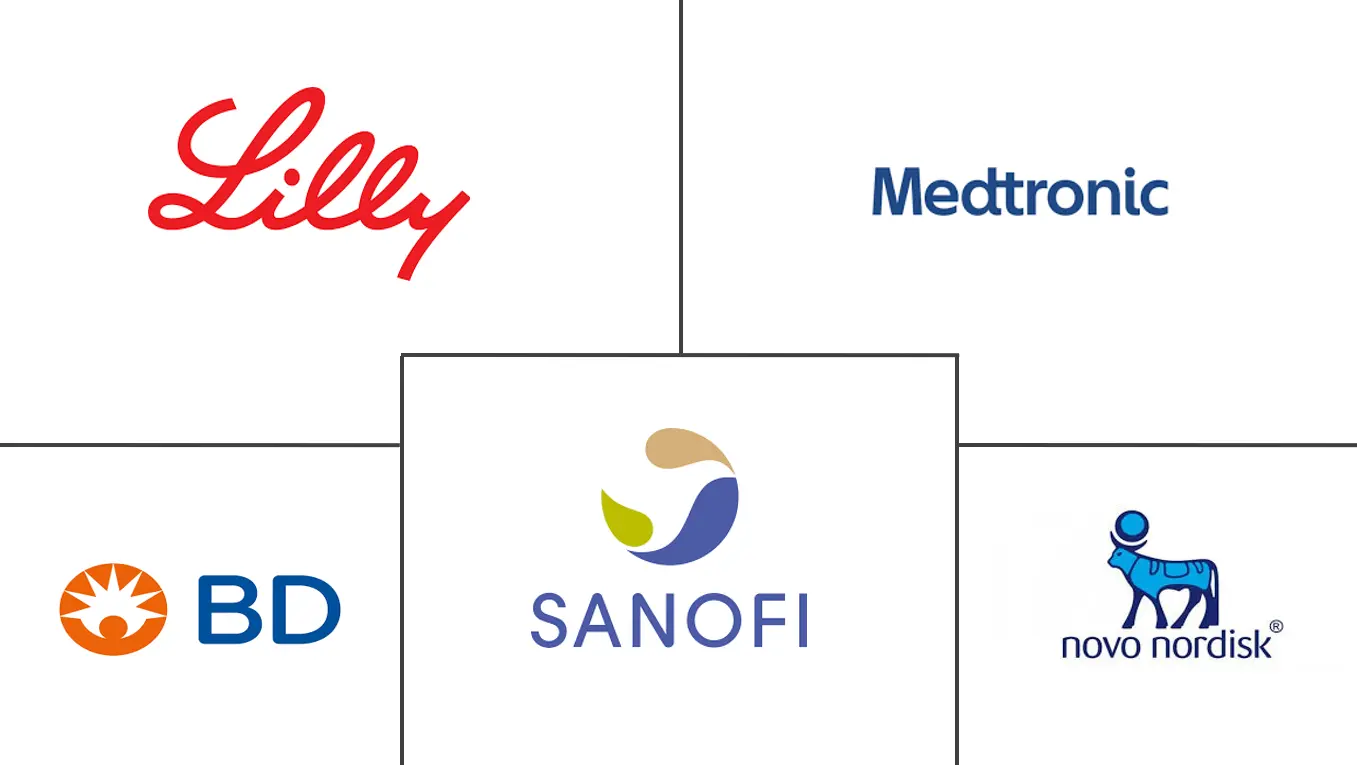
*Disclaimer: Major Players sorted in no particular order |
Europe Insulin Delivery Devices Market Analysis
The Europe Insulin Delivery Devices Market size is estimated at USD 2.83 billion in 2024, and is expected to reach USD 3.12 billion by 2029, growing at a CAGR of 1.9% during the forecast period (2024-2029).
During the COVID-19 pandemic, patients with diabetes were at higher risk for hospitalizations and complications due to hyper- or hypoglycemia, metabolic comorbidities, and more severe illness from SARS-CoV-2 infection. According to an article, “Costs of COVID-19 Pandemic associated with Diabetes in Europe: A Health Care Cost Model,” published in 2021, the estimated cost per hospital admission during the first wave of COVID-19 in Europe ranged from EUR 25,018 (USD 26,744.24) for type 2 diabetes patients in good glycemic control to EUR 57,244 (USD 61,193.84) for type 1 diabetes patients in poor glycemic control, reflecting a higher risk of intensive care, ventilator support, and a longer hospital stay. The estimated cost for patients without diabetes was EUR 16,993 (USD 18,165.52). The expected total direct expenditures for COVID-19 secondary care in Europe were 13.9 billion euros (USD 14.86 billion). Diabetes treatment thus accounted for 23.5% of total expenditures.
Insulin is a hormone that controls blood sugar levels by signaling the liver mus,cle, and fat cells to take in glucose from the blood. It helps cells take in glucose to be used for energy. Type 1 diabetes is when the pancreas produces too little insulin to meet the body's requirements. Type 1 diabetes management is complex and highly individualized. People with Type 1 diabetes need synthetic insulin every day or multiple times a day to control blood sugar levels. Type 1 diabetes makes up 5 to 15% of the total diabetes population, and prevention ways have not yet been defined. Screening for type 1 diabetes is essential for an effective management strategy. Treatment for type 1 diabetes includes daily multiple injections of insulin or using an insulin delivery device.
Technological advancements in insulin delivery devices have increased for safer and more accurate insulin administration. In April 2021, Medtronic introduced the Medtronic Extended infusion set in selected European countries as the first and only infusion set that may be worn for up to 7 days. An infusion set is tubing that delivers insulin from the pump to the body and typically requires a set change every few days. This innovation doubles the time an infusion set may be worn so users can safely stay on insulin pump therapy with fewer interruptions and insertions while introducing enhanced convenience and comfort to their diabetes management routine. The set is compatible with all MiniMed 600 and 700 series insulin pumps.
Therefore, owing to the aforementioned factors, the market studied is anticipated to grow over the analysis period.
Europe Insulin Delivery Devices Market Trends
Insulin Pump segment is expected to witness highest growth during the forecast period
An insulin pump is expected to register the highest CAGR of more than 3.8% in the market during the forecast period because of the increasing technological advancement and its preference over other traditional methods due to continuous insulin administration. An insulin pump is a device that delivers insulin continuously or automatically whenever required. The pump mimics the human pancreas. The insulin infusion pump works as an alternative to the traditional system of daily injections or an insulin pen.
According to the IDF 2021, the overall diabetes expenditure in Europe among the population aged 20-79 years was USD 156 billion, and it is expected to increase to USD 174 billion by 2040. According to other statistics from IDF, every year, 21,600 children are added to the type-1 diabetic population pool. These figures indicate that approximately 9% of the total healthcare expenditure is spent on diabetes in Europe. In Europe, a variety of insulin pumps are available. Traditional insulin pumps have an insulin reservoir and pumping mechanism attached to the body with tubing and an infusion set, and the other insulin patch pumps are worn directly on the body and have a reservoir, pumping mechanism, and infusion set inside a small case. Patch pumps are controlled wirelessly by a separate device that allows the programming of insulin delivery for meals from the patch. Most insurance companies in Europe cover insulin pump therapy with variable out-of-pocket expenses.
Insulin pump therapy is a well-established insulin administration method for people with type 1 diabetes (T1DM). Pumps are a validated, time-tested therapeutic option in T1DM at all ages, enabling near-physiological insulin delivery in situations where the pancreas does not produce insulin. There are even pump models with remote controls enabling parents of young children to either suspend or bolus insulin from a distance when the child is playing or eating. The insulin infusion pumps reduce the large swings in blood glucose levels, induce less pain, and deliver more accurately when compared to injections. The use of continuous subcutaneous insulin infusion and continuous glucose monitoring systems (CGMs) has improved patient care and quality of life. It is widely used in the ambulatory setting. Increasingly, this technology is also being used in the hospital setting. The technology combines glucose monitoring using a CGM with advanced algorithms in the insulin pump to predict low glucose and suspend insulin delivery.
Technological innovations in the insulin pump device market will likely drive the market during the forecast period. There are different ways to inject insulin into a patient’s body, using syringes, pens, pumps, and jet injectors, giving them various options for insulin delivery. The European insulin delivery devices market is segmented by type (insulin pumps, insulin syringes, cartridges in reusable pens, disposable pens, and jet injectors) and geography. The report offers the value (USD) and volume (unit) for the above segments.
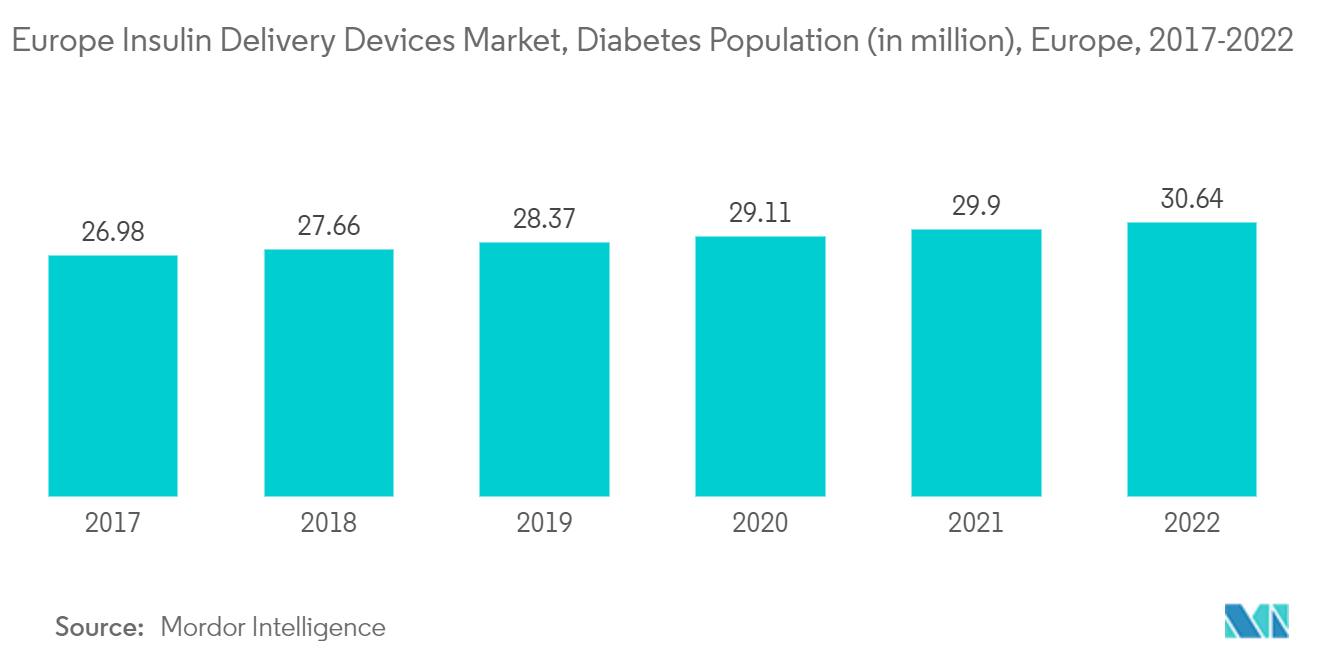
The United Kingdom is expected to dominate the European insulin delivery devices market
In the United Kingdom, the rate of newly diagnosed cases of Type 1 and Type 2 diabetes is seen to increase, mainly due to obesity, unhealthy diet, and physical inactivity. The rapidly increasing incidence and prevalence of diabetic patients and healthcare expenditure are indications of the increasing usage of diabetic care products.
According to The British Diabetic Association, Diabetes Prevalence 2021 data shows an increase in the number of people living with a diabetes diagnosis in the United Kingdom: an increase of more than 150,000 from the previous year. It is estimated that more than 13.6 million people are at increased risk of type 2 diabetes in the United Kingdom. At this rate, the number of people with diabetes, including the undiagnosed population, is expected to rise to 5.5 million by 2030.
The National Service Framework (NSF) program is improving services by setting national standards to drive service quality and tackle variations in care. The Association of British HealthTech Industries (ABHI) launched a diabetes section, enabling diabetes technology companies to work together in the first forum of its kind. The ABHI group is for any health technology company interested in diabetes care, from CGM and insulin pumps to apps. Such advantages have helped the adoption of these products in the UK market. The United Kingdom is expected to dominate the market due to factors such as the easy availability of insulin delivery devices and high consumer awareness.
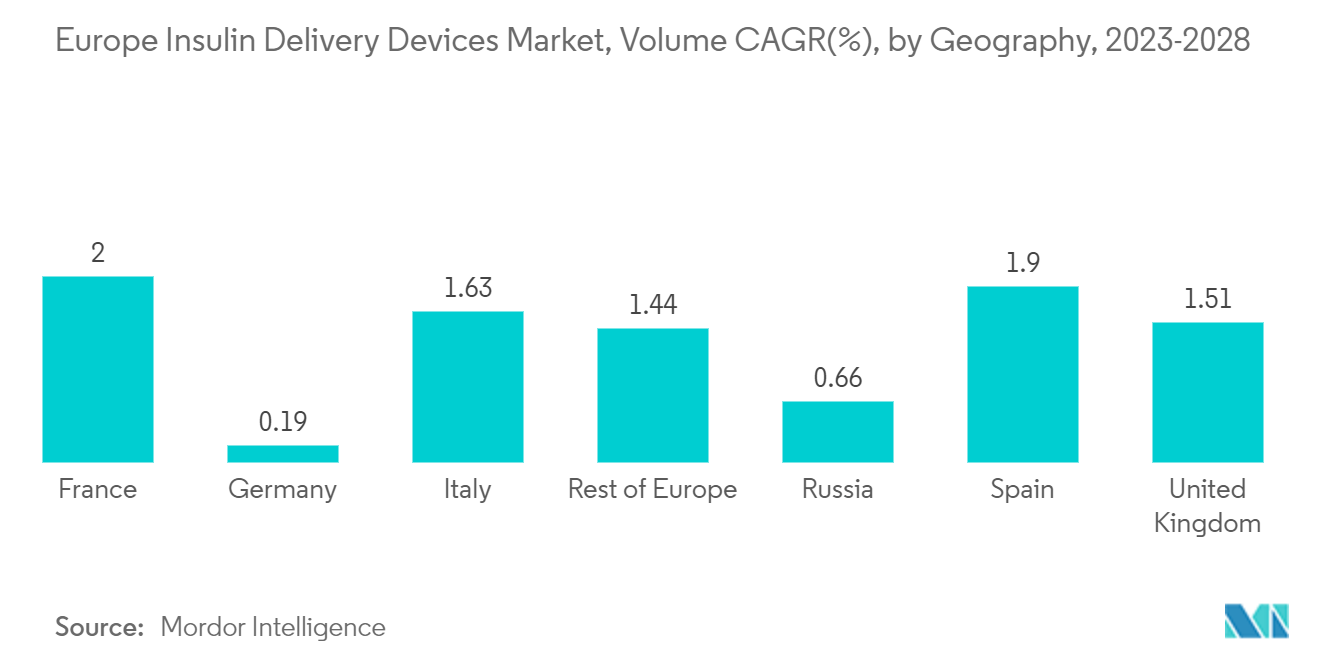
European Insulin Delivery Devices Industry Overview
The European insulin delivery devices market is consolidated due to the presence of only a few major companies operating globally and regionally. The competitive landscape includes an analysis of a few international as well as local companies that hold market shares and are well known, including Novo Nordisk, Sanofi, Eli Lily and Company, Medtronic, Insulet, Ypsomped, and Becton Dickinson and Company.
Europe Insulin Delivery Devices Market Leaders
-
Eli Lilly and Company
-
Medtronic PLC
-
Sanofi Aventis
-
Becton Dickinson and Company
-
Novo Nordisk A/S
*Disclaimer: Major Players sorted in no particular order
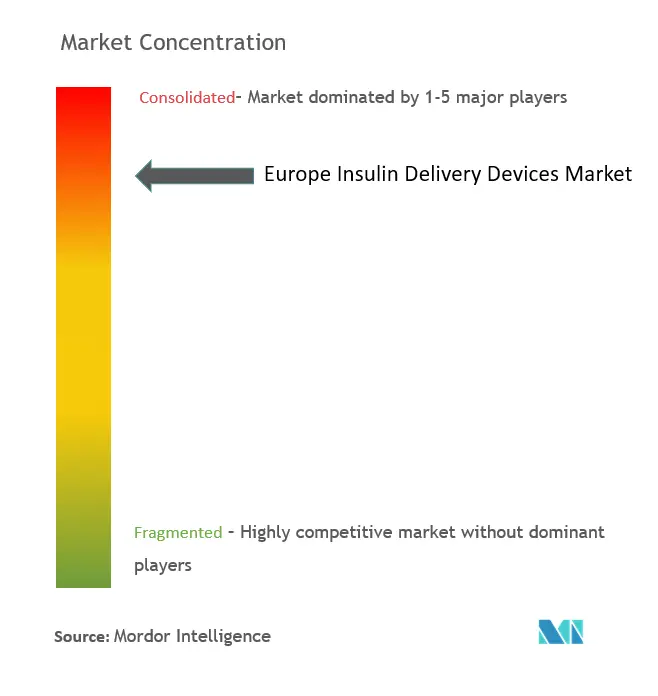
Europe Insulin Delivery Devices Market News
- October 2022: Medtronic introduced a new program called My Insights, which is exclusively made for individuals using the MiniMed 770G system. Using an individual's data, My Insights relies on the power of data science to provide personalized tips, trends, and reminders that customers can use to help with their diabetes management goals. My Insights personalized recommendations are shared via a monthly email with educational content that is most relevant to what an individual may currently be experiencing. This is the first program in diabetes management that goes beyond generalized tips and instead shares personalized suggestions using data from an integrated pump system.
- April 2022: CamDiab and Ypsomed announced the partnership to develop and commercialize an integrated automated insulin delivery (AID) system to help lessen the burden of diabetes management for people with diabetes in European countries. The new integrated AID system is designed to connect Abbott's FreeStyle Libre 3 sensor, the world's most miniature and most accurate continuous glucose monitoring sensor, to CamDiab's CamAPS FX mobile app, which connects with Ypsomed's mylife YpsoPump, creating a smart, automated process to deliver insulin based on real-time glucose data. The connected, smart wearable solution is designed to continuously monitor a person's glucose levels and automatically adjust and have the right amount of insulin at the right time, removing the guesswork of insulin dosing.
Europe Insulin Delivery Devices Market Report - Table of Contents
1. INTRODUCTION
- 1.1 Study Assumptions and Market Definition
- 1.2 Scope of the Study
2. RESEARCH METHODOLOGY
3. EXECUTIVE SUMMARY
4. MARKET DYNAMICS
- 4.1 Market Overview
- 4.2 Market Drivers
- 4.3 Market Restraints
-
4.4 Porter's Five Forces Analysis
- 4.4.1 Bargaining Power of Suppliers
- 4.4.2 Bargaining Power of Consumers
- 4.4.3 Threat of New Entrants
- 4.4.4 Threat of Substitute Products and Services
- 4.4.5 Intensity of Competitive Rivalry
5. MARKET SEGMENTATION
-
5.1 By Device
- 5.1.1 Insulin Pumps
- 5.1.1.1 By Technology
- 5.1.1.1.1 Tethered Insulin Pump
- 5.1.1.1.2 Tubless Insulin Pump
- 5.1.1.2 By Component
- 5.1.1.2.1 Insulin Pump Device
- 5.1.1.2.2 Reservoir
- 5.1.1.2.3 Infusion Sets
- 5.1.2 Insulin Syringes
- 5.1.3 Insulin Pens
- 5.1.3.1 Reusable Pens
- 5.1.3.2 Disposable Pens
- 5.1.4 Jet Injectors
-
5.2 Geography
- 5.2.1 France
- 5.2.2 Germany
- 5.2.3 Italy
- 5.2.4 Russia
- 5.2.5 Spain
- 5.2.6 United Kingdom
- 5.2.7 Rest of Europe
6. MARKET INDICATORS
- 6.1 Type 1 Diabetes Population
- 6.2 Type 2 Diabetes Population
7. COMPETITIVE LANDSCAPE
-
7.1 COMPANY PROFILES
- 7.1.1 Novo Nordisk AS
- 7.1.2 Sanofi
- 7.1.3 Eli Lilly and Company
- 7.1.4 Medtronic PLC
- 7.1.5 Insulet Corporation
- 7.1.6 Ypsomed
- 7.1.7 Becton Dickinson and Company
- *List Not Exhaustive
-
7.2 COMPANY SHARE ANALYSIS
- 7.2.1 Novo Nordisk AS
- 7.2.2 Sanofi
- 7.2.3 Eli Lilly and Company
- 7.2.4 Others
8. MARKET OPPORTUNITIES AND FUTURE TRENDS
** Subject To AvailablityEurope Insulin Delivery Devices Industry Segmentation
There are different ways to inject insulin into a patient’s body, using syringes, pens, pumps, and jet injectors, giving them various options for insulin delivery. The European insulin delivery devices market is segmented by device (insulin pumps, insulin syringes, cartridges in reusable pens, disposable pens, and jet injectors) and geography. The report offers the market size in value terms in USD and the volume in units for all the abovementioned segments.
| By Device | Insulin Pumps | By Technology | Tethered Insulin Pump |
| Tubless Insulin Pump | |||
| By Device | Insulin Pumps | By Component | Insulin Pump Device |
| Reservoir | |||
| Infusion Sets | |||
| By Device | Insulin Syringes | ||
| Insulin Pens | Reusable Pens | ||
| Disposable Pens | |||
| Jet Injectors | |||
| Geography | France | ||
| Germany | |||
| Italy | |||
| Russia | |||
| Spain | |||
| United Kingdom | |||
| Rest of Europe |
Europe Insulin Delivery Devices Market Research Faqs
How big is the Europe Insulin Delivery Devices Market?
The Europe Insulin Delivery Devices Market size is expected to reach USD 2.83 billion in 2024 and grow at a CAGR of 1.9% to reach USD 3.12 billion by 2029.
What is the current Europe Insulin Delivery Devices Market size?
In 2024, the Europe Insulin Delivery Devices Market size is expected to reach USD 2.83 billion.
Who are the key players in Europe Insulin Delivery Devices Market?
Eli Lilly and Company, Medtronic PLC, Sanofi Aventis, Becton Dickinson and Company and Novo Nordisk A/S are the major companies operating in the Europe Insulin Delivery Devices Market.
What years does this Europe Insulin Delivery Devices Market cover, and what was the market size in 2023?
In 2023, the Europe Insulin Delivery Devices Market size was estimated at USD 2.78 billion. The report covers the Europe Insulin Delivery Devices Market historical market size for years: 2019, 2020, 2021, 2022 and 2023. The report also forecasts the Europe Insulin Delivery Devices Market size for years: 2024, 2025, 2026, 2027, 2028 and 2029.
Europe Insulin Delivery Devices Industry Report
Statistics for the 2024 Europe Insulin Delivery Devices market share, size and revenue growth rate, created by Mordor Intelligence™ Industry Reports. Europe Insulin Delivery Devices analysis includes a market forecast outlook to for 2024 to 2029 and historical overview. Get a sample of this industry analysis as a free report PDF download.



